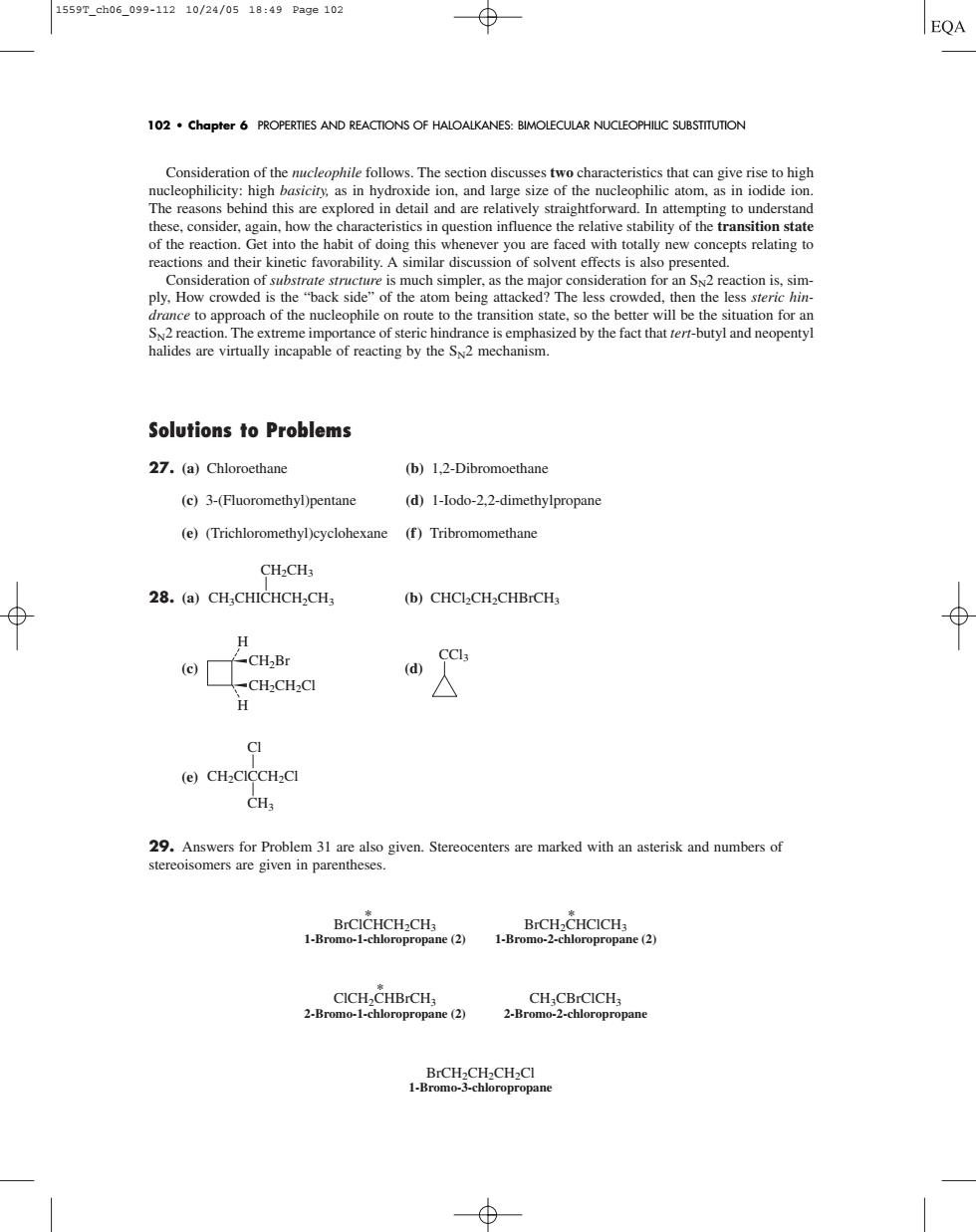正在加载图片...

1559T_ch06_099-11210/24/0518:49Pa9e102 ⊕ EQA 102.Chapter 6 PROPERTES AND REACTIONS OF HALOALKANES:BIMOLECULAR NUCLEOPHILIC SUBSTITUTON Consideration of the ncleophile follows The section discusses two nucleophilicity: .Ge into the habit of don this henever you re ons and their kinctic favorability.A similar discussion of solvent Solutions to Problems 27.(a)Chlorocthane (b)1.2-Dibromoethane (c)3-(Fluoromethyl)pentane (d)1-lodo-2.2-dimethylpropane (e)(Trichloromethyl)cyclohexane (f)Tribromomethane 28.(a)CH;CHICHCH2CH3 (b)CHCLCH-CHBICH ⊕ H -CH2Br (d) △ H (e)CH2CICCH2CI 29.Answers for Problem 31 are also given.Stereocenters are marked with an asterisk and numbers of stereoisomers are given in parentheses .CH. opane(2) H:CBrCICH3 ne (2) 2-Bro 2-chloropropan Consideration of the nucleophile follows. The section discusses two characteristics that can give rise to high nucleophilicity: high basicity, as in hydroxide ion, and large size of the nucleophilic atom, as in iodide ion. The reasons behind this are explored in detail and are relatively straightforward. In attempting to understand these, consider, again, how the characteristics in question influence the relative stability of the transition state of the reaction. Get into the habit of doing this whenever you are faced with totally new concepts relating to reactions and their kinetic favorability. A similar discussion of solvent effects is also presented. Consideration of substrate structure is much simpler, as the major consideration for an SN2 reaction is, simply, How crowded is the “back side” of the atom being attacked? The less crowded, then the less steric hindrance to approach of the nucleophile on route to the transition state, so the better will be the situation for an SN2 reaction. The extreme importance of steric hindrance is emphasized by the fact that tert-butyl and neopentyl halides are virtually incapable of reacting by the SN2 mechanism. Solutions to Problems 27. (a) Chloroethane (b) 1,2-Dibromoethane (c) 3-(Fluoromethyl)pentane (d) 1-Iodo-2,2-dimethylpropane (e) (Trichloromethyl)cyclohexane (f ) Tribromomethane 28. (a) (b) CHCl2CH2CHBrCH3 (c) (d) (e) 29. Answers for Problem 31 are also given. Stereocenters are marked with an asterisk and numbers of stereoisomers are given in parentheses. BrClCHCH2CH3 1-Bromo-1-chloropropane (2) * BrCH2CHClCH3 1-Bromo-2-chloropropane (2) * ClCH2CHBrCH3 2-Bromo-1-chloropropane (2) * CH3CBrClCH3 2-Bromo-2-chloropropane BrCH2CH2CH2Cl 1-Bromo-3-chloropropane Cl CH3 CH2ClCCH2Cl CH CCl3 2Br H H CH2CH2Cl CH2CH3 CH3CHICHCH2CH3 102 • Chapter 6 PROPERTIES AND REACTIONS OF HALOALKANES: BIMOLECULAR NUCLEOPHILIC SUBSTITUTION 1559T_ch06_099-112 10/24/05 18:49 Page 102